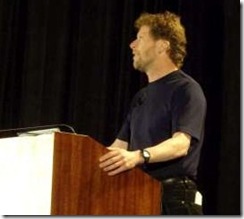 San Jose, CA. Behold: Alistair Cockburn. At the end of SEPG-Europe 2008, I was in a conversation with SEPG program chair, Dr. Caroline Graettinger. We were discussing the theme of the 2009 series of SEPG conferences on Next Generation of process. I immediately thought of and fired off an email to Alistair. Intrigued, he said that he's working on a very similar sounding set of ideas calling them, Software Development in the 21st Century, and accepted shortly thereafter.
San Jose, CA. Behold: Alistair Cockburn. At the end of SEPG-Europe 2008, I was in a conversation with SEPG program chair, Dr. Caroline Graettinger. We were discussing the theme of the 2009 series of SEPG conferences on Next Generation of process. I immediately thought of and fired off an email to Alistair. Intrigued, he said that he's working on a very similar sounding set of ideas calling them, Software Development in the 21st Century, and accepted shortly thereafter.
This ideas are based in metaphors to help really manage software development the way software is really developed. Cooperative Games, Craft, and Lean. The details of this talk are on Alistair's web site.
Alistair was poignant (despite mentioning me by name) and funny and fielded questions from the audience. Kudos my friend.
Another Jim as Sr. Director for Software Quality, Jim Sartain, currently at Adobe, came next. Previously at Intuit and before then HP. Leading with the fact that TSP goes where he goes. (See more later.) He showed the same slide from yesterday's Intuit presentation showing "most admired companies" where Intuit is #1 and Adobe is #2.
ANOTHER "quality" person with a REAL personality! A clean-sweep for great SEPG speakers! Too bad the economy kept more people from experiencing them!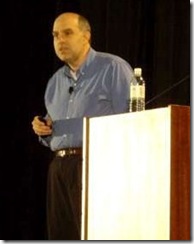
Jim spoke about giving engineers the tools and work-life balance that can double their productivity and morale. Note: research this when there's time. And while I'm at it, research why it's the commercial companies of the world who truly embrace quality culture and the government-oriented ones don't. (Never mind, that's rhetorical.)
Wanna "get" how serious they are? They frakking flew Watts Humphrey in to San Jose to launch TSP and brought as many engineers from around the world in to hear it. But since their operations in India are so significant, they did it again in India!
Their results with TSP are beyond quality improvements, but work-life balance, team commitment, team self-direction, senior leadership buy-in (removing 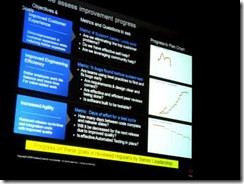 obstacles). TSP provided a means of measuring the effort and using that data to negotiate better expectations. (Both Alistair and Jim noted the importance of metrics to transparency and improvement.) Jim also took questions including why to wrap TSP in Scrum. Reasons: (1) Product owner, and (2) defined "done" at each iteration. It turns out that TSP came to Adobe, not because of Jim bringing it rather because people at Adobe heard the great TSP stories coming from Intuit and "want sum'dat!"
obstacles). TSP provided a means of measuring the effort and using that data to negotiate better expectations. (Both Alistair and Jim noted the importance of metrics to transparency and improvement.) Jim also took questions including why to wrap TSP in Scrum. Reasons: (1) Product owner, and (2) defined "done" at each iteration. It turns out that TSP came to Adobe, not because of Jim bringing it rather because people at Adobe heard the great TSP stories coming from Intuit and "want sum'dat!"
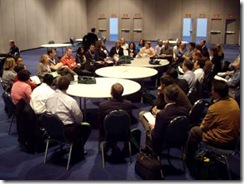 A first for SEPG, was the inclusion of time between the morning's keynotes and lunch for very user-group-esque "peer to peer" sessions. Conference participants self-selected into table-top discussions driven by other attendees, not selected by the conference program. In fact, attendees put up topics and volunteered to lead them -- or put up topics in hopes of someone else showing up to lead and play subject-matter-expert. To no-one's surprise, David Anderson signed up for agile and lean discussions. (David's in the ruddy color left of center in the image.) And, again, to no-one's surprise, there were more people interested in this topic than room at any one table, so the conference logisticians moved the crowd to its own room where, as can be seen in the photo, numbered several dozen people. Subsequent to this image, more arrived and were standing around the seated area. One might sense a trend of growing interest in this population for the last few years whenever the terms "CMMI" and "Agile" are put together, eh? As it turns out, of the several simultaneous peer-to-peer sessions, the two with the most participants were the Agile-related one and the TSP one.
A first for SEPG, was the inclusion of time between the morning's keynotes and lunch for very user-group-esque "peer to peer" sessions. Conference participants self-selected into table-top discussions driven by other attendees, not selected by the conference program. In fact, attendees put up topics and volunteered to lead them -- or put up topics in hopes of someone else showing up to lead and play subject-matter-expert. To no-one's surprise, David Anderson signed up for agile and lean discussions. (David's in the ruddy color left of center in the image.) And, again, to no-one's surprise, there were more people interested in this topic than room at any one table, so the conference logisticians moved the crowd to its own room where, as can be seen in the photo, numbered several dozen people. Subsequent to this image, more arrived and were standing around the seated area. One might sense a trend of growing interest in this population for the last few years whenever the terms "CMMI" and "Agile" are put together, eh? As it turns out, of the several simultaneous peer-to-peer sessions, the two with the most participants were the Agile-related one and the TSP one.
(Well, super insider's double-hush secret preview scoop of things to come: expect Agile, Lean, and TSP to start showing more prominently both at SEPG and throughout the work being done at SEI.)
David lead Achieving High Maturity with Kanban mini-tutorial. His talk was mostly about the culture necessary to achieve high 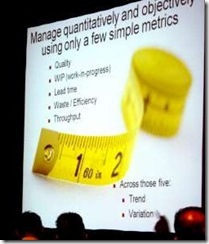 maturity and how Kanban can facilitate it that. But describing it that way makes it sound like it was a commercial for Kanban. It wasn't. It was about culture's and measurement's roles in maturity of development, productivity, quality and production management. How the data drives the actions of the teams and these actions can be demonstrably linked to things that can actually be managed. One way to summarize is in how he said, that "level 5" results are achievable by setting expectations of level 5 behavior as a matter of culture. It's telling that David's session spanned 2 normal sessions. People had the opportunity to leave mid-way and go to other sessions. Despite other session opportunities, there was a net gain of attendees in David's session.
maturity and how Kanban can facilitate it that. But describing it that way makes it sound like it was a commercial for Kanban. It wasn't. It was about culture's and measurement's roles in maturity of development, productivity, quality and production management. How the data drives the actions of the teams and these actions can be demonstrably linked to things that can actually be managed. One way to summarize is in how he said, that "level 5" results are achievable by setting expectations of level 5 behavior as a matter of culture. It's telling that David's session spanned 2 normal sessions. People had the opportunity to leave mid-way and go to other sessions. Despite other session opportunities, there was a net gain of attendees in David's session.
 After that, came me.
After that, came me.
The CMMI Guide to the Perplexed.
Well-attended, many friendly faces and most people seemed to enjoy it. Lots of positive feedback... of course, detractors seldom tell you to your face, do they! You can get the presentation here.
Labels: Alistair Cockburn, David Anderson, Kanban
 San Jase, CA. Actually there won't, unfortunately, be much to report today as I was side-tracked from all but one session. The session I attended was an experience report from a lead appraiser working with a company whose total size was all of 12 individuals. In fact, they were a distributed workforce with no central offices. Everyone worked from home. This was a report on how they achieved CMMI ML3. The company itself had very impressive results made possible by very impressive people and attitudes. Let's get one (or two) things straight immediately: (1) they really truly were ML3, no corners cut, they really truly did the work of defining, managing and using their processes, (2) they did NOT need CMMI to be disciplined -- to a person they were highly skilled, highly technical, supremely professional, absolutely committed their work and company, incredibly laid-back, and deadly serious about NOT causing themselves work that was not fun and benefit the work and company.
San Jase, CA. Actually there won't, unfortunately, be much to report today as I was side-tracked from all but one session. The session I attended was an experience report from a lead appraiser working with a company whose total size was all of 12 individuals. In fact, they were a distributed workforce with no central offices. Everyone worked from home. This was a report on how they achieved CMMI ML3. The company itself had very impressive results made possible by very impressive people and attitudes. Let's get one (or two) things straight immediately: (1) they really truly were ML3, no corners cut, they really truly did the work of defining, managing and using their processes, (2) they did NOT need CMMI to be disciplined -- to a person they were highly skilled, highly technical, supremely professional, absolutely committed their work and company, incredibly laid-back, and deadly serious about NOT causing themselves work that was not fun and benefit the work and company. San Jose, CA. Behold:
San Jose, CA. Behold: 

 obstacles). TSP provided a means of measuring the effort and using that data to negotiate better expectations. (Both Alistair and Jim noted the importance of metrics to transparency and improvement.) Jim also took questions including why to wrap TSP in Scrum. Reasons: (1) Product owner, and (2) defined "done" at each iteration. It turns out that TSP came to Adobe, not because of Jim bringing it rather because people at Adobe heard the great TSP stories coming from Intuit and "want sum'dat!"
obstacles). TSP provided a means of measuring the effort and using that data to negotiate better expectations. (Both Alistair and Jim noted the importance of metrics to transparency and improvement.) Jim also took questions including why to wrap TSP in Scrum. Reasons: (1) Product owner, and (2) defined "done" at each iteration. It turns out that TSP came to Adobe, not because of Jim bringing it rather because people at Adobe heard the great TSP stories coming from Intuit and "want sum'dat!"  A first for SEPG, was the inclusion of time between the morning's keynotes and lunch for very user-group-esque "peer to peer" sessions. Conference participants self-selected into table-top discussions driven by other attendees, not selected by the conference program. In fact, attendees put up topics and volunteered to lead them -- or put up topics in hopes of someone else showing up to lead and play subject-matter-expert. To no-one's surprise,
A first for SEPG, was the inclusion of time between the morning's keynotes and lunch for very user-group-esque "peer to peer" sessions. Conference participants self-selected into table-top discussions driven by other attendees, not selected by the conference program. In fact, attendees put up topics and volunteered to lead them -- or put up topics in hopes of someone else showing up to lead and play subject-matter-expert. To no-one's surprise,  maturity and how Kanban can facilitate it that. But describing it that way makes it sound like it was a commercial for Kanban. It wasn't. It was about culture's and measurement's roles in maturity of development, productivity, quality and production management. How the data drives the actions of the teams and these actions can be demonstrably linked to things that can actually be managed. One way to summarize is in how he said, that "level 5" results are achievable by setting expectations of level 5 behavior as a matter of culture. It's telling that David's session spanned 2 normal sessions. People had the opportunity to leave mid-way and go to other sessions. Despite other session opportunities, there was a net gain of attendees in David's session.
maturity and how Kanban can facilitate it that. But describing it that way makes it sound like it was a commercial for Kanban. It wasn't. It was about culture's and measurement's roles in maturity of development, productivity, quality and production management. How the data drives the actions of the teams and these actions can be demonstrably linked to things that can actually be managed. One way to summarize is in how he said, that "level 5" results are achievable by setting expectations of level 5 behavior as a matter of culture. It's telling that David's session spanned 2 normal sessions. People had the opportunity to leave mid-way and go to other sessions. Despite other session opportunities, there was a net gain of attendees in David's session.
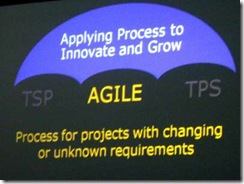
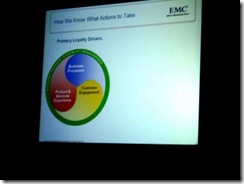 Jim Bampos
Jim Bampos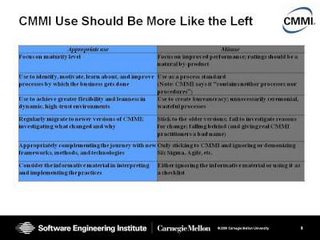

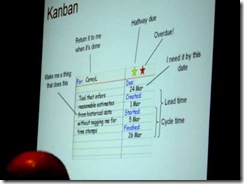


-200.jpg)
